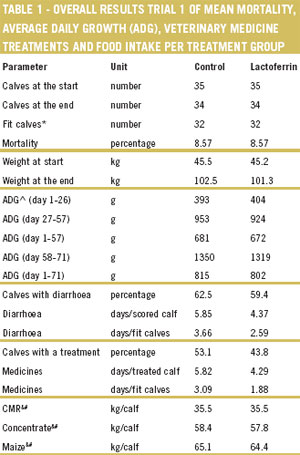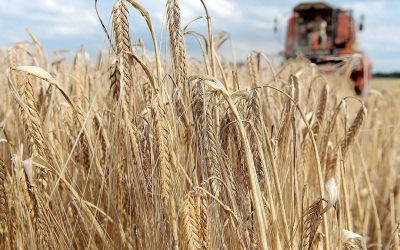Lactoferrin supplementation for claves (part 2)

In the first part of this two part series on lactoferrin in calf diets we look at the theoretical background of the ingredient and its benefits for the animal. In this article, Johan Lemmen explains three trials in which lactoferrin was added to calf milk replacers.
The goal of these trials (2006-2008) was to test the effect of lactoferrin on growth performance and health of rearing calves from the age of 0-8 weeks. The hypothesis is that lactoferrin stimulates oxidative processes, supports the immune system and develops and protects the intestine. The feed intake and daily gain will be increased and the veterinary medicine treatments will be decreased by lactoferrin addition in the calf milk replacers (CMR).
Trials
In the first trial with 70 Holstein bull calves (ranging in age from 10-15 days) two levels of lactoferrin were tested. One group without and one group received 200 ppm lactoferrin in the diet. The results are shown in Table 1. In the second trial, 52 Holstein bull calves (ranging in age from 10-15 days) were used.
The positive control group obtained lactoferrin by a premix in the dosage of 200 ppm. The lactoferrin was 80 times diluted by cheese whey and added to the milk by a medicine mixer machine. In this trial, the haemoglobin levels were measured in week 0, 4 and 8. Results are shown in Table 2. In the third trial, 60 Holstein bull calves (ranging in age from 10-15 days) were also split in two identical treatment groups. The positive control group obtained lactoferrin by a premix in the dosage of 200 ppm. The lactoferrin was 80 times diluted by cheese whey and added to the milk by a medicine mixer machine. Results are shown in Table 3.
Discussion and conclusions
In the first trial, the control group realised a small advantage in the average daily growth during the complete trial. CMR-intake was the same and roughage and concentrate intake is nearly the same between both groups. The percentage of calves with diarrhoea was equal between the groups but the number of veterinary medicine treatments was lower as well as the number of days with a veterinary medicine treatment per scored and per fit calf with lactoferrin supplementation, although not statistically different.
The feed intake and daily gain were comparable to the performances of the control group. In the second trial (a repetition of the first trial), it was shown that the mortality was higher in the control group. The average daily gain was increased with the lactoferrin addition, which resulted in an extra growth of 50 gram per day. The number of veterinary treatment days per fit calf was significantly lower with lactoferrin addition. An effect of lactoferrin addition on haemoglobin levels in blood was not observed, because the haemoglobin level progress is comparable for both groups. Lactoferrin addition increases the iron levels in blood according to the literature (Kume and Tanabe, 1996). Due to an increase of iron absorption from CMR a higher amount of body iron in red blood cells was reported. In trial 3, the daily gain was the same for both groups. CMR-intake was the same and roughage and concentrate intake was nearly the same between both groups. The percentage of calves with diarrhoea was significantly different. The number of diarrhoea cases decreased with 200 ppm lactoferrin supplementation but the feed intake and daily gain was comparable with the performance of the control group.
Final conclusion
Overall, lactoferrin addition results in increased average daily gain and healthier calves. This is confirming the hypothesis, that lactoferrin supports the immune system, and develops and protects the intestine.
Differences in feed intake were not reported in both trials. The addition of 200 ppm lactoferrin is therefore desirable from both a performance and an economical standpoint.











